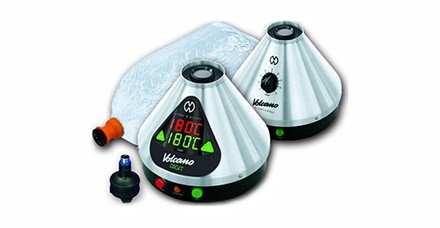 : 10off
: 10off : Today
: TodayShopping Cart - 0 item
You have no items in your shopping cart.
Vaping vs Smoking: Is Vaporizer Really a Healthier Option?

One of the most popular questions that vape shop owners and employees get asked on a regular basis is whether dry herb vaporizers are a healthy alternative to traditional smoking. Unfortunately, there’s no clear-cut, easy answer for this question. Due to the fact that vaporizers are only now entering the mainstream marketplace, scientists have just begun to examine the health effects of dry herb vaporizers and other vaping products. That being said, early research has illustrated a number of promising benefits for those who have chosen to use a vaporizer rather than smoking herbs or tobacco using traditional cigarettes. In fact, a number of experts are recommending that vaporizers be used by individuals who are hoping to discover new tools to quit smoking.

- Top 4 Vaporizer Research & Studies
- Vaping vs Smoking
- What Is Vaping?
- Is Vaping Bad for You?
- Side Effects and Health Risks of Vaping
- What Is a Vape?
- Vaping to Quit Smoking
- What Is an E Cigarette?
- What Is a Vaporizer?
- Are Vaporizers Bad for You?
- Vaping without Nicotine
- Benefits of Vaping
- Does a Vape Have Nicotine?
- Why Do People Vape?
Unique Smoking Methods

Based upon the underlying science describing how traditional cigarette smoke and vapor interact with the body, scientists are almost certain that vaping has the potential to be markedly healthier for the body. When you light a cigarette, you instantly begin to burn a variety of potentially toxic materials inside of the wrapper. Combustion produces smoke, and smoke naturally contains carcinogens, or substances known to cause cancer, as well as a variety of dangerous toxins. Smoke also contains tar, which has been known to coat the lungs and, ultimately, result in breathing problems.
Vaping does not involve combustion, nor does it produce smoke. When you place dry herbs or tobacco inside of a vaporizer, the device heats the blend you have chosen to a very hot temperature, resulting in the vapor that has helped to give these devices their name. In comparison to smoke created by traditional cigarettes, the vapor produced by dry herb vaporizers and other vaping products is 95% free of carcinogens. Also, vaporizers do not contain tar, which will help ensure healthier lungs over time. As an added benefit, many also consider vaping to be a substantially more flavorful experience.

While there is, obviously, much more to learn about vaping and its effect on the human body, four landmark studies have helped revealed a variety of potential benefits of these products. More information can be found below:
Vaporizer Study No. 1*
In 2001, researchers testing the M1 Volatizer vaporizer unit deduced that the vapor produced by this device contained significantly fewer toxins than smoke produced during traditional cigarette combustion.

Vaporizer Study No. 2*
A 2006 study undertaken at Leiden University in the Netherlands concluded that the Volcano Vaporizer was less harmful to the respiratory system when compared to smoking the same blends using traditional cigarettes.

Vaporizer Study No. 3*
A 2007 test conducted by a combined team of scientists from the University of Southern California and the University of New York at Albany evaluated the health effects of prolonged vaping. The scientists interviewed 7,000 vaping enthusiasts and smokers in an effort to identify respiratory symptoms that they may have been experiencing. The results highlighted the fact that people who vaped instead of smoked were 40% less likely to report negative physical health symptoms when compared to traditional smokers of the same age and sex.

Vaporizer Study No. 4*
Yet another 2007 study conducted at the University of California, San Francisco, shed light on the quantity of carbon monoxide, a toxic gas, released by vaporizers during use. Ultimately, the study concluded that vaporizers were not actively contributing to the build-up of carbon monoxide in the environment.
While it is important to always keep in mind that an "official" study has yet to be released which offers comprehensive information regarding long-term use of vaporizing products, current research indicates that vaporizers are far better for the body than normal cigarettes.
Interested in learning more about the different types of vaporizers on the market today? Let us help you find the best vaporizer to match your personal preferences. We look forward to assisting you!
References: See study findings below
- Vaporizer Study No. 1* - tandfonline.com Journal of Therapeutics
- Vaporizer Study No. 2* - ucsf.edu By Jeff Sheehy
- Further studies on vaporizing: Maps.org

Many people are curious about smoking vs vaping, wondering "Is vaping safer than smoking?" or "Is vaping worse than smoking?" While studies are still being done to evaluate vaping vs. smoking, the research that has been done so far suggests that vaping is likely a safer way to benefit from nicotine than smoking.
Cigarette smoke contains 4000 chemicals. A total of 43 cancer-causing chemicals are contained in smoke produced by cigarettes, including carbon monoxide, tar, formaldehyde, cyanide, DDT, arsenic, and ammonia. E-juice used in electronic cigarettes usually contains nothing but food grade flavorings, propylene glycol, and glycerin. None of these substances have been shown to have toxic potential. As a result, in the match-up of vape vs cigarette, vaping is generally safer because it exposes you to fewer toxins. Research has also shown that vaping is gentler on the lungs and respiratory passages than smoking.
Keep in mind that smoking and vaping can both expose you to nicotine. In studies, nicotine has been shown to be a carcinogen.
So is vaping better than smoking? The answer is likely, yes, but we need more research to understand precisely what the long-term effects of vaping are.
Vaping refers to inhaling vapor produced by a device known as a vaporizer pen or e-cigarette. The device is filled with e-liquid: a mix of propylene glycol, vegetable glycerin, flavors, and sometimes nicotine. A heating element in the device makes the liquid hot and causes it to release vapor that has the flavor of the e-juice and nicotine (if there is nicotine in the e-liquid). The vapor can then be inhaled into the lungs.

Many people ask "Is vaping bad?" or "Is vaping safe?" The truth is that vaping is still relatively new, so there hasn't been enough time to study what long-term dangers of vaping might be.
E cigarette health effects have been examined through some preliminary studies. The primary ingredients in e-juice used for vaping are vegetable glycerin and propylene glycol. Both of these substances have been shown to be nontoxic.
In addition, most of the flavoring agents have been proven to be nontoxic, although one ingredient--diacetyl--has been shown to cause lung problems and should be avoided. Most e-juice manufacturers have stopped using it, though.
If you're considering the question "Are e cigarettes safe?" it's important to remember that the nicotine found in some e-juice products has been shown to be a carcinogen. Many doctors believe that while it’s probably not a good idea to start vaping for reasons other than to reduce the effects of nicotine, vaping is a better choice than cigarettes for those who use nicotine.

Most vaping side effects are relatively minor and include:
- Dryness of the skin
- Dryness of the mouth
- Dryness of the eyes
- Burning sensations on the face
- Skin rashes
- Puffiness of the eyes
- Increased sensitivity to caffeine
- Nose bleeds
- Dizziness
- Canker sores in the mouth
Many of these e cigarette side effects develop when you first begin to vape and resolve once your body becomes accustomed to vaping. One vaping health effect that you should be aware of is dehydration. The ingredients in e-juice do eliminate water from the body, so it's important that you drink 8 to 10 glasses of water per day.
Some people are allergic to ingredients in e-juice. Propylene glycol is the most common cause of allergic reactions. People who react to the substance can vape vegetable glycerin-based e-liquid that is 100 percent propylene glycol free.
There are some potential negative health risks of vaping. While vaping has been shown to be easier on the lungs and respiratory passages than smoking, studies indicate that it does cause some inflammation.
As previously mentioned, diacetyl, a flavoring found in some e-juice products, has been linked to lung disease and is generally not recommended. Exposure to nicotine has been shown to increase the risk of cancer, and teenagers exposed to nicotine may suffer from memory and attention problems later in life.

Vape is a general term for a device that is used for vaping. The term can apply to e-cigarettes and to vaporizer pens. Vape can also be used as an action verb for using a vaporizer pen or e-cigarette. For example, you might say “I vape instead of smoking.”
Many people today wonder if vaping will help them quit smoking. You can do a quick Internet search and find thousands of stories from people who have used electronic cigarettes and vaporizers to get nicotine, so that they could stop smoking cigarettes.
Still, there isn't a lot of scientific evidence to prove that vaping helps people quit smoking. A small study at the King’s College London Institute of Psychiatry, Psychology, and Neuroscience did find evidence that using an e-cigarette daily made it easier for people to quit.
In the United States, vaping devices are not approved by the U.S. Food and Drug Administration (FDA) as smoking cessation devices, so they cannot be marketed to help people quit. Despite this, many people do find that vaping makes it easier to give up tobacco.

An e cigarette is a device used for vaping. A true e cigarette looks similar to a tobacco cigarette. It has a built-in battery and comes filled with e-juice. You can usually take 100 to 300 draws from an e cigarette before the e-liquid runs out. Then, you throw the e cigarette away and buy a new one. To answer your further vape pen questions, click here.
A vaporizer is a device used for vaporizing dry herbs and aromatherapy.
Vaporizers consist of a rechargeable battery, a chamber for holding your vaping material, and a mouthpiece. The vaporizer can be refilled again and again; however, most have parts that need to be replaced, such as heating coils or screens. To see how vaporizers work, click here.
As with vaping in general, research into the health effects of vaporizers is still ongoing. Compared to smoking, vaporizers are generally considered to be safer because they expose the body to fewer toxins and are less irritating to the lungs.
There still could be some negative health effects to using vaporizers due to the substances that they contain. As previously explained, nicotine in e-juice has been linked to some forms of cancer.

Many people assume that if they see someone using a vaporizer or e cigarette; the individual is using nicotine; however, that's not always the case. You can purchase e-juice products that are 100 percent nicotine free.
Nicotine-free e-juice can be used by people who vape because they want to enjoy the flavor, as well as for individuals who used to smoke and miss inhaling substances but no longer need nicotine. To read more about nicotine, click here.
There are a number of benefits to vaping, including:
- Less exposure to toxins
- Less irritation to the lungs and respiratory passages
- Less costly than cigarettes
- No cigarette odors or smell
- Less impact to the teeth and gums
A study conducted by the Center for the Study of Tobacco Products at Virginia Commonwealth University (VCU) in Richmond concluded that the potential benefits of vaping are likely to outweigh any risks associated with electronic cigarettes, especially for people who are using them in place of tobacco cigarettes.

First off, it's important to understand that a vape is a device, so no vape actually has nicotine in it. What could contain nicotine is what you put inside of a vape. E-juice or e-liquid that is used for vaping may or may not contain nicotine, depending on the product.
Disposable electronic cigarettes that are pre-filled with e-juice nearly always contain nicotine in their e-liquid. Vaporizer pens that you fill with your own e-juice will only have nicotine in them if you select an e-liquid that has nicotine as one of its ingredients.

There is no one single answer to this question.
Some people vape because they want to quit smoking and continue to get the benefits of nicotine. These people may use an electronic cigarette in place of a tobacco cigarette for the rest of their lives.
Other people will gradually decrease the amount of nicotine in their e-juice until they're no longer using any nicotine at all. At that point, they may stop vaping entirely or continue to vape nicotine-free e-juice because they like the oral experience.
People may vape because they like the flavor of the e-juice or because they like the feeling of inhaling the vapor. Some people vape because they don't like the smell of cigarettes or don't want to have to worry about exposing people to secondhand smoke.





